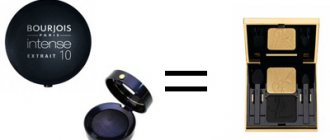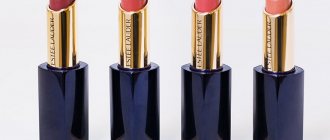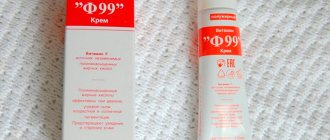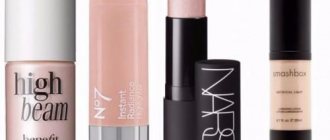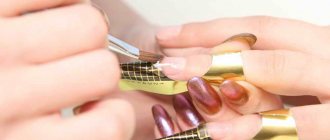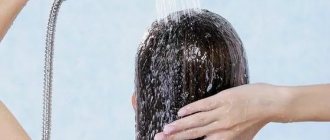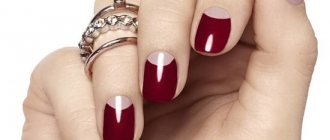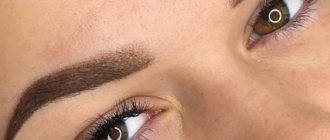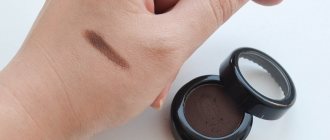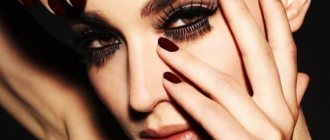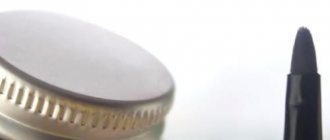Today, manicures made using a relatively new American product called Shellac are extremely popular among fashionistas all over the world.
It all started in 2010, when the American company CND introduced the world to an innovative series of gel polishes. Since then, many similar products have been released, others have become a household name.
When we talk about shellac manicure, we mean coating the nail with a special gel polish . You shouldn't compare shellac with nail extensions. Coating a nail with gel polish is a simple procedure that resembles a regular manicure with colored varnish applied to the nail.
The difference lies not only in the composition of shellac, but also in the fact that after applying each layer, the nail must be dried in an ultraviolet lamp.
This manicure can last three weeks, remaining just as bright and intact. After three weeks, the shellac should be removed, as the overgrown nail becomes too noticeable.
A manicure using shellac can be done not only in a salon, but also independently at home . Remember that the beauty of a manicure and its longevity depend on the correct execution of each stage of the work.
Preparing nails for manicure
In order to do a shellac manicure yourself at home, you will need to complete the following preparatory steps:
- Any manicure should begin with tidying up the nails, giving the same shape and length to all nails, and removing dirt and varnish residues. To do this, we will need a nail file, manicure scissors and other manicure set accessories.
- Treat cuticles with cuticle remover or soften with cuticle oil and then remove. Try to remove as much cuticle as possible. Since you plan to have a manicure for at least two weeks, it is advisable that the cuticles are not visible for a long time.
- In order for the base to fit well on the nail, you should first sand it. A medium abrasive buffer is best suited for this job.
- Now the nail needs to be degreased. Before you begin degreasing your nail, clean it thoroughly. It is best to wash your hands and dry them with a towel. There is a special product for degreasing, which is not cheap. You can replace it with regular alcohol wipes or acetone.
Is it possible to apply shellac to peeling nails?
Applying shellac to a problematic nail surface is highly not recommended. Why? Shellac will cause peeling nails if they were not strengthened or were severely damaged before the procedure. This coating negatively affects the nail plate and can ruin it.
During the treatment of peeling nails, constant care of their surface is important, which is impossible while the nail plate is covered with a durable layer of shellac. A competent specialist in this type of manicure will always advise you to cure before applying the gel.
Primer
Immediately after degreasing the nail plate, apply a primer.
The primer is a kind of primer before applying shellac..
It is thanks to this cosmetic product that any varnishes and gels will stay on the nail for a long time.
The primer functions not only as an adhesive, but also as a disinfectant. Despite the fact that the primer dries out the top layer of the nail plate, it does not have a harmful or destructive effect.
The primer is applied along the edge of the nail. You should not dry a nail coated with primer in a lamp; it is better to wait for it to dry naturally, especially since this stage will not take much time. As a rule, one minute is enough.
If your nails are peeling, what vitamin is missing?
Even if there was mechanical damage to the nail plate, you need to balance your diet, otherwise healing will be long and difficult. There are a number of vitamins and minerals, the lack of which always leads to problems with skin, hair, and nails.
- Sulfur. This element is necessary for strong nails. It is found in large quantities in brewer's yeast, walnuts, liver, and sprouted cereals.
- Magnesium. This substance is difficult to obtain from everyday foods, so it is better to compensate for its deficiency with the help of vitamin and mineral complexes.
- Protein. Protein is essential for healthy growth and is abundant in animal products: meat, milk, butter. Legumes, such as soy, also contain a lot of protein.
- Selenium. This element is important for healthy skin and nails. There is a lot of it in sea fish, coconuts, and pistachios.
- Silicon. Without this substance, the nail surface becomes fragile. To make up for the deficiency, you need to consume more oats and barley.
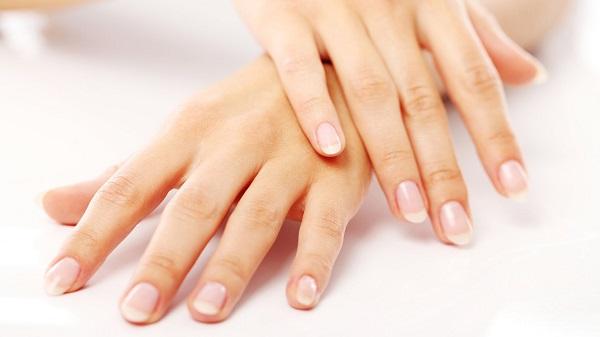
Some of these elements are difficult to absorb directly from foods, so after consulting a doctor, you can start taking mineral complexes.
Base and top
The desire to do a manicure using shellac at home is most often explained by the desire to save money. If you're getting a manicure for the first time, the total amount of all the necessary purchases can be scary.
Only after a few months will your investment begin to pay off. Despite the large expenses, don’t even think about giving up buying a shellac base. Applying varnish directly to the finish is a big mistake and will lead to disappointment and cracked colored varnish.
If the primer protects the nail from the effects of the coating, then the base is responsible for preserving the color and integrity of the varnish for several weeks. A manicure done without a base may peel off within a week.
The top protects the colored layer of manicure on top. This product is also very important for manicure using any type of varnish. Every day our nails are subjected to various tests. In order for the color coating to last as long as possible, it also needs protection. This is exactly the type of protection that the top is.
Creating a manicure using shellac has many nuances, due to which this manicure looks luxurious for a long time. To obtain the desired result, you need to observe all the subtleties of craftsmanship.
How often should you go to a nail specialist?
It is impossible to determine exactly how long shellac will last. This is due to the individual characteristics of not only the woman herself, but also her lifestyle, the quality of the material and its application, and so on. On average, you don’t have to worry about the beauty of your hands for about 3 weeks. Some ladies visit their master once a month or even less often.
The instructions for shellac also have a specific figure - 2 weeks. It is during this time that manufacturers guarantee even color, shine and no chipping. But how long it will actually last cannot be answered with certainty. In the first 14 days, the cuticle grows an average of one and a half millimeters, so the strip of bare nail remains invisible if the shellac is applied deep enough.
Interestingly, shellac-coated toenails will delight you with the expressiveness of their color and the durability of your manicure for much longer.
Experts do not give a definite answer as to whether cleaning products affect gel polish. However, it is still recommended to wear gloves when doing housework. Even if nothing happens to shellac, household chemicals are harmful to the skin of your hands.
Color layer
The color palette from CND is updated annually, so you have a large selection of different shades, the choice can only be limited by your preference. Apply the color coat carefully and dry your nails in an ultraviolet lamp for about 2 minutes at 36 W.
Try to apply the layer as thin as possible. If you apply a thick layer of varnish, it will swell during the drying process, and you will have to go back to the very beginning and do the whole job again, starting with degreasing your nails.
One coat will look pale and will be almost transparent. Therefore, a second layer is necessary .
It, just like the first one, should be thoroughly dried with a lamp.
Application
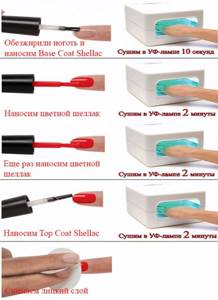
Below we will discuss the technology and technique of coating nails with shellac gel polish in one color. Once you master this process, you will be able to create more complex designs. For example, French manicure is not much more complicated. The application of designs and patterns can also be flawless with a little practice. In addition, it is easy to apply glitter onto such a gel, which will also last a long time and not lose its aesthetics.
The technique of applying shellac manicure is not so different from painting with regular varnish.
- Apply a brush stroke along one edge of the nail;
- The second stroke is placed along the opposite side of the nail plate;
- The third stroke is applied in the center of the plate;
- Remember that it is important to carefully seal the ends of the nails with the coating.
This application avoids an excessively thick layer of coating, which may wrinkle when drying. The technology for applying shellac nail polish, which is presented in the video, is much more complex, since it requires a large number of materials and devices. The technological process of how to properly make shellac gel at home is described step by step below.
- Apply a base coat that will protect your nails. The layer should be as thin as possible. Don't forget to seal the ends. Dry the base for 1 minute under a UV lamp or 12 seconds under an LED lamp;
- Although video tutorials show all the steps and the entire procedure for applying shellac, they often do not show the tricks known to professionals. For example, the coating must be prepared before application. The bottle must be rolled in your palms several times, so that the pigment is distributed as evenly as possible throughout the composition;
- Apply color coat. Correct application of shellac gel polish is possible if you follow the technique described above step by step, the video also provides this information. There is no need to seal the tips of your nails. The layer should be as thin as possible;
- Dry the coating under the lamp for 1 – 2 minutes. If the layer was too thick, it will swell. In this case, you will have to redo all the work, starting with degreasing;
- Now let’s talk about how shellac is applied as a second layer. This is necessary because the first layer looks desaturated and almost transparent. The second layer should be slightly thicker than the first, but there is no need to overdo it;
- Dry everything under the lamp for 2 minutes;
- Apply a fairly thick layer of top coat and cure for 120 seconds under a lamp;
- The next step after the shellac has dried is removing the sticky layer. You will need a special lint-free cloth. One can argue for a long time about what exactly and what composition to remove the sticky layer of shellac with. Special products are quite expensive, but alcohol or acetone work just as well. However, non-specialized compositions can deprive the coating of its shine, so it’s worth experimenting.
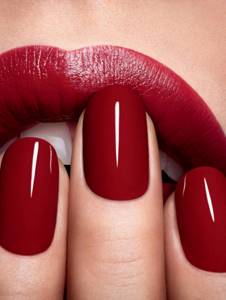
Color coating
This is a complete answer to the question of how shellac is applied to nails, as well as the rules and technology of application; with a video clip, knowledge can be consolidated visually. You should not expect that on the first try you will get the same result as in the salon. But after several trainings you will already know exactly how to use and work with shellac, and therefore you will get an excellent result.
Shellac lamp
A lamp plays a big role in manicure using shellac . The process of drying a nail is called polymerization. For this process, one of three types of lamps will suit us:
- Ultraviolet;
- LED;
- Gas-light, cold cathode.
The most popular are ultraviolet lamps, largely due to the fact that they were the first. LED lamps carry out the polymerization process much faster.
Where an ultraviolet lamp requires 2 minutes, an LED lamp requires 2 seconds. But it should be borne in mind that LED lamps do not dry all types of gels and varnishes.
Cold cathode lamps are considered the most functional today.
This lamp dries all existing varnishes, does not have a negative effect on the skin of the hands, and polymerizes quickly enough.
How to properly coat with shellac?
An even tone and shine are a sign of beautiful nails and well-groomed hands. In order to achieve the desired result, you need to carry out the Shellak coating procedure in several stages:
- Dry manicure (without the use of creams or oils);
- Giving the desired shape to the nails and leveling the surface of the plate with a nail file;
- Polishing the surface of the nail with a buff (this allows you to achieve a better level of adhesion to the coating);
- Cleaning from dust with a special soft brush;
- Degreasing the surface followed by drying;
- Apply the base in a very thin layer with the obligatory sealing of the tip of the nail;
- Drying in a lamp (1.5 minutes);
- Applying the main tone (thin layer);
- Drying in a lamp (1.5 minutes);
- The main tone is applied a second time in a thicker layer, and the tips of the nails are necessarily sealed;
- Drying (2 minutes);
- Applying the finish;
- Drying (2 minutes);
- Removing the sticky layer with a special product.
Remover
Shellac can not only be applied independently, but also removed independently. The CND company has provided the market not only with products for creating long-lasting and colorful manicures, but also with products for removing shellac.
It is the CND product that large beauty salons prefer to use; they are also used at home.
This product is intended not only for easy removal of manicure, it also contains caring components that allow not only not to cause harm to the nail, but also to provide nutrition and care during the procedure.
Shellac removers are not only produced by CND.
Many companies offer their own analogue products. Domestic manufacturers are trying not to give in and are already ready to offer their product called Severina.
This product is not much inferior to its foreign competitors, but it is more affordable. Therefore, among professionals and amateurs, it is the Russian shellac remover that ranks second in popularity.
We can highlight such companies as Lady Victory, Jerden and Bluesky. Their products are also worthy of attention.
In order for a manicure at home to be as good as a salon one, you need to treat each stage of the work carefully and do everything strictly according to the instructions.
harm from shellac
SODIUM NITRATE IS A CONCEROGEN, SODIUM GLUTAMATE IS A FLAVOR ENHANCER IS STRICTLY PROHIBITED IN BABY FOOD AND THEN JUDGE FOR YOURSELF, EVERYWHERE IS FULL OF DAMAGE, BUT THERE ARE THE MOST IN READY SEASONINGS - STUPIDLY THE CONCENTRATION IS HIGHER!
IT'S FOR YOU TO JUDGE WHETHER YOU EAT THE PERIODIC TABLE OR NOT!
ALL ABOUT THE HARMFUL FOOD ADDITIVES (E...)
Food additives (E...) Can everything be eaten? Do you pay attention to the composition of certain food products on the packaging? Author: Valery
In Russia, only five additives are officially prohibited: E-121 (a citrus red dye that people like to use on orange peels); E-123 (amaranth) is a specific dye, nothing to do with the plant of the same name; E-240 - formaldehyde, a very toxic substance - the same one in which frogs and other organic things are “alcoholized”; E-924a and E-924b - they were previously used to improve flour.
The rest of the world bans many more food additives. You need to know the substances so that when you see ominous numbers on the packaging, you firmly put it aside.
Cause malignant tumors: E103 E105 E121 E123 E125 E126 E130 E131 E142 E152 E210 E211 E213–217 E240 E330 E447 Cause gastrointestinal diseases: E221–226 E320–322 E338–341 E407 E450 E46 1–466 Allergens: E230 E231 E232 E239 E311 –313 Causes liver and kidney diseases: E171–173 E320–322
Many food additives are of natural origin. For example, E330 - citric acid - is found in all citrus fruits. Tomatoes contain E160a - carotene, E101 - vitamin B2 riboflavin. E400, sodium alginate, is isolated from seaweed. Sorbic and benzoic acids and their salts are preservatives that are also found in nature, in particular in mountain ash, lingonberries, and cranberries. What product do you think contains this combination of food additives: acetic acid E260, tartaric acid E334, glutamic acid E620, carotene E160a, niacin E375, anthocyanin E163, citric acid E330, succinic acid E363, cystine E920, vitamin C E300, vitamin B E101? This is an ordinary apple!
Food additives: RELATIVELY not harmful: E 100, 101, 104, 105, 111, 122, 126, 130, 132, 151, 152, 160, 161, 162, 163, 170, 174, 175, 181, 200, 201, 202, 203, 236, 260, 261, 262, 270, 280, 290, 300, 301, 306, 307, 322, 326, 327, 331, 332, 333, 334, 335, 336, 337, 382, 400 , 401, 402, 404, 405, 406, 410, 411, 413, 414, 420, 421, 422, 440, 471, 472, 473 Suspicious food additives: E 125, 141, 150, 153, 171, 172, 173, 173, 173, 173, 173, 173 240, 241, 477 Hazardous food additives: E 102, 110, 120, 124
ADDITIVES THAT CAUSE HARM TO HEALTH: Negatively affecting intestinal function: E 220, 221, 222, 223, 224 Negatively affecting food digestion: E 338, 339, 340, 341, 450, 461, 463, 465, 466, as well as - found in ice cream e 407 (I don’t know, maybe in Russia there is no such additive in ice cream) Food additives that cause harm to the skin: E 230, 231, 232, 233 Additive that interferes with the absorption of vitamin B 12: E 200 Additive that increases cholesterol: E 320, 321 Increasing the sensitivity of the nervous system: E 311, 312 Causing putrefactive processes in the mouth and harm to the body: E 330, used in many lemonades and many other products (from myself - oddly enough - this is citric acid. It is artificial or something ? Isn’t it made from lemons?) Additives that can cause cancer: E 131, 142, 210, 211, 213, 214, 215, 216, 217 Very dangerous additives!!!!!!, provoking the growth of cancer cells E 123, 102, 110 - the latter is often used in caramels, fruit syrups, chocolate bars, fish fingers, ready-made sauces, some soft cheeses and puddings.
DYES (E-100 – E-199) E-100 Curcumin Harmless, of natural origin E-102 Tartarazine Prohibited for use by asthmatics, provokes attacks E-103 Alkanet, alkanine Causes skin reactions (dermatitis, eczema) E-104 Quinoline yellow Gives symptoms acute food poisoning (nausea, vomiting, diarrhea). Banned in the EU, USA and a number of other countries E-107 Yellow – 2G Prohibited for use by asthmatics, provokes attacks E-110 Yellow “sunset” FCF, orange-yellow S Gives symptoms of acute food poisoning (nausea, vomiting, diarrhea). Banned in the EU, USA and a number of other countries E-120 Cochineal; carminic acid; carmines At a concentration of more than 0.0005 grams per 100 g of product, it is poisonous! E-121 Citrus red-2 Banned in Russia and most countries of the world! E-122 Azorubine, carmoisine Banned in the EU, USA and a number of other countries, considered a carcinogen! E-123 Amaranth Banned in Russia and most countries of the world! Proven - causes malformations in the fetus E-124 Ponceau-4R (crimson-4R), cocheline red-A Banned in the EU, USA and a number of other countries, considered a carcinogen, provokes asthma attacks E-125 Ponceau, crimson-SX Banned in the EU, USA and a number of other countries, considered a carcinogen E-127 Erythrosine Banned in the EU, USA and a number of other countries, promotes the development of thyroid diseases E-128 Red-2G Banned in the EU, USA and a number of other countries, considered a carcinogen E- 129 Red Charm-AC Banned in the EU, USA and a number of other countries, considered a carcinogen E-131 Blue Patented-V Banned in the EU, USA and a number of other countries, considered a carcinogen E-132 Indigotine, indigo carmine Banned in Norway, affects blood pressure , causes dermatitis E-133 Blue shiny-FCF Banned in the EU, USA and a number of other countries, considered a carcinogen E-142 Green S Banned in the EU, USA and a number of other countries, considered a carcinogen E-151 Black shiny-BN, black-PN Banned in the EU, USA and a number of other countries, considered a carcinogen E-153 Vegetable charcoal Banned in the EU, USA and a number of other countries, considered a carcinogen E-154 Brown-FK Banned in the EU, USA and a number of other countries, considered a carcinogen E-155 Brown-HT Banned in the EU, USA and a number of other countries, considered a carcinogen E-160 Paprika extra, capsanthin, capsorubin Banned in the EU, US and a number of other countries E-160d Lycopene E-166 Sandalwood E-173 Aluminum Banned in the EU, USA and a number of other countries E-174 Silver Banned in the EU, USA and a number of other countries E-175 Gold Banned in the EU, USA and a number of other countries E-180 Ruby lithol-VK Banned in the EU, USA and a number of other countries, considered a carcinogen E-181 Edible tannins E-182 Orseil, orsin
PRESERVATIVES (E-200 – E-299) E-200 Sorbic acid Causes allergies, most often skin rashes E-209 Parahydroxybenzoic acid heptyl ester May cause headaches E-210 Benzoic acid Prohibited for use by asthmatics, provokes attacks E-213 Benzoate calcium E-214 Parahydroxybenzoic acid ethyl ester Banned in the EU E-215 Parahydroxybenzoic acid ethyl ester sodium salt Banned in the EU, USA and a number of other countries E-216 Parahydroxybenzoic acid propyl ester Banned in the EU, USA and a number of other countries E-217 Parahydroxybenzoic propyl ester acid sodium salt Banned in the EU, USA and a number of other countries E-218 Parahydroxybenzoic acid methyl ester Skin allergic reactions are possible E-219 Parahydroxybenzoic acid methyl ester sodium salt Banned in the EU E-220 Sulfur dioxide Not for people with kidney disease E -221 Sodium sulfite E-225 Potassium sulfite E-226 Calcium sulfite Banned in the EU, USA and a number of other countries E-227 Calcium hydrosulfite E-228 Potassium hydrosulfite (potassium bisulfite) Banned in the EU, USA and a number of other countries E-230 Biphenyl , biphenyl Banned in the EU, USA and a number of other countries E-231 Orthophenylphenol Banned in the EU, USA and a number of other countries E-232 Sodium orthophenylphenol E-233 Thiabendazole E-234 Nisin Banned in the EU, USA and a number of other countries E-235 Natamycin (pimaricin) In large quantities gives symptoms of acute food poisoning (nausea, vomiting, diarrhea) E-236 Formic acid Banned in the EU, USA and a number of other countries E-237 Sodium formate Banned in the EU, US and a number of other countries E-238 Formate calcium Banned in the EU, USA and a number of other countries E-239 Hexamethylenetetramine Banned in the EU, USA and a number of other countries! E-240 Formaldehyde Banned in Russia and most countries of the world! E-241 Guaiac resin E-249 Potassium nitrite Carcinogen. It is strictly forbidden to use E-252 Potassium nitrate in baby food In most European countries it is prohibited to use E-261 Potassium acetate Contraindicated for people with kidney disease E-263 Calcium acetate E-264 Ammonium acetate In large quantities it gives symptoms of acute food poisoning (nausea, vomiting , diarrhea) E-281 Sodium propionate May cause headaches E-282 Calcium propionate May cause headaches E-283 Potassium propionate May cause headaches E-284 Boric acid E-285 Sodium tetraborate (borax) E-296 Malic (malic) acid It is strictly forbidden to use it in baby food E-297 Fumaric acid
E-200 Sorbic acid Sorbic Acid Possible skin irritation, destruction of vitamin B12 E-201 Sodium sorbate Sodium Sorbate E-202 Potassium sorbate Potassium Sorbate E-203 Calcium sorbate Calcium sorbate E-209 ** Para-hydroxybenzoic acid heptyl ester Heptyl p-hydroxybenzoate E-210 Benzoic acid Benzoic Acid Causes allergic reactions, can lead to the formation of malignant tumors, carcinogen E-211 Sodium benzoate Sodium Benzoate Causes allergic reactions, can lead to the formation of malignant tumors, carcinogen E-212 Potassium benzoate Potassium Benzoate Causes allergic reactions E- 213 ** Calcium benzoate Calcium Benzoate Causes allergic reactions, can lead to the formation of malignant tumors, carcinogen E-214 ** Para-hydroxybenzoic acid ethyl ester Ethyl p-hydroxybenzoate Carcinogen, can lead to the formation of malignant tumors E-215 ** Para-hydroxybenzoic ethyl ester acid sodium salt Sodium Ethyl p-hydroxybenzoate Carcinogen, can lead to the formation of malignant tumors E-216 ** Para-hydroxybenzoic acid propyl ester Propyl p-hydroxybenzoate Causes allergic reactions, carcinogen. They affect vascular tone and reduce blood pressure. Can lead to the formation of malignant tumors. Used in the meat and confectionery industry E-217 ** Para-hydroxybenzoic acid propyl ester sodium salt Sodium Propyl p-hydroxybenzoate Carcinogen. They affect vascular tone and reduce blood pressure. Can lead to the formation of malignant tumors. Used in the meat and confectionery industry E-218 ** Para-hydroxybenzoic acid methyl ester Methyl p-hydroxybenzoate Skin allergic reactions E-219 ** Para-hydroxybenzoic acid methyl ester sodium salt Sodium Methyl p-hydroxybenzoate E-220 Sulfur dioxide Sulfur Dioxide Can cause fatal allergic reactions in asthmatics, destroys vitamin B1, damages the digestive organs. Destroys vitamin B12 E-221 Sodium sulfite Sodium Sulphite Sm 220 E-222 Sodium hydrosulfite Sodium Hydrogen Sulphite Sm 220 E-223 Sodium pyrosulfite Sodium Metabisulphite Sm 220 E-224 Potassium pyrosulfite Potassium Metabisulphite Sm 220 E-225 ** Potassium sulfite Potassium Sulphite Sm 220 E-226 ** Calcium sulfite Calcium Sulphite E-227 ** Calcium hydrosulfite Calcium Hydrogen Sulphite E-228 ** Potassium hydrosulfite (potassium bisulfite) Potassium Hydrogen Sulphite Cm 220 E-230 ** Biphenyl, diphenyl Biphenyl, Diphenyl Can used for agricultural needs E-231 ** Orthophenylphenol Orthophenyl Phenol Cm 230 E-232 ** Sodium Orthophenyl Phenol Cm 230. Causes skin diseases E-233 ** Thiabendazole Cm 230. Causes skin diseases E -234 Nisin Nisin E-235 Natamycin (Pimaricin) Natamycin (Pimaricin) May cause nausea, vomiting, diarrhea and skin irritation E-236 Formic acid Formic Acid E-237 ** Sodium formate Sodium Formate E-238 * * Calcium formate Calcium Formate E-239 Hexamethylenetetramine Hexamethylene Tetramine Carcinogen, can lead to the formation of malignant tumors E-240 * Formaldehyde Formaldehyde May lead to the formation of malignant tumors E-241 ** Guaiac resin Gum Guaicum E-242 Dimethyl dicarbonate Dimethyl Dicarbonate E-249 Potassium Nitrite Potassium Nitrite Prohibited for use in baby food products. May cause weakness, headaches, difficulty breathing, carcinogen E-250 Sodium nitrite Sodium Nitrite Cm 249, adding it to food leads to the formation of a small amount of protein cancer-forming elements, carcinogen. Increases blood pressure E-251 Sodium nitrate Sodium Nitrate Sm 250, carcinogen. E-252 ** Potassium nitrate Potassium Nitrate Cm 249, carcinogen E-260 Acetic acid Acetic Acid E-261 Potassium acetate Potassium Acetate It is recommended to avoid people with kidney disease E-262 Sodium acetates: sodium acetate, sodium hydroacetate (sodium diacetate) Sodium Acetates (i) Sodium Acetate (ii) Sodium Hydrogen Acetate (Sodium Diacetate) E-263 ** Calcium Acetate Calcium Acetate E-264 ** Ammonium Acetate Ammonium Acetate May cause nausea and vomiting E-265 Dehydroacetic Acid E-266 Sodium Dehydroacetate Sodium Dehydroacetate E-270 Lactic Acid May cause problems in young children E-280 Propionic Acid E-281 ** Sodium Propionate E-282 ** Calcium Propionate Calcium Propionate Possibility of migraines E-283 ** Potassium Propionate Potassium Propionate Sm 281 E-284 Boric acid Boric Acid Sm 281 E-285 Sodium tetraborate (borax) Sodium Tetraborate (Borax) E-290 Carbon dioxide Carbon Dioxide Increases the effect of alcohol on the body E-296 Malic acid Malic Acid E-297 Fumaric acid Fumaric Acid
TASTE AND AROMAT ENHANCERS (E-600 – E-699) E-620 Glutamic acid, salt substitute It is strictly forbidden to use it in baby food E-621 Monosodium glutamate It is strictly forbidden to use it in baby food E-622 Monopotassium glutamate It gives symptoms in large quantities acute food poisoning (nausea, vomiting, diarrhea) E-625 Magnesium glutamate E-627 Disodium guanylate It is strictly prohibited to use in baby food E-629 Calcium 5-guanylate E-630 Ionisic acid E-631 Disodium ionisinate It is strictly forbidden to use in children's food nutrition E-635 5-sodium ribonucleotides disubstituted Banned in the EU, USA and a number of other countries
GLAZING AGENTS, BREAD AND FLOUR IMPROVERS AND OTHER SUBSTANCES (E-900 – E-999) E-900 Dimethylpolysiloxane E-901 Beeswax, white and yellow Should be avoided by people allergic to pollen, honey, etc. E-902 Candle wax Natural origin E-903 Carnauba wax Natural origin E-904 Shellac Produced from insects; known cases of acute allergies E-905a Vaseline oil of Natural origin E-905b Vaseline Natural origin E-905c Paraffin of Natural origin E-906 Benzoin gum of Natural origin E-908 Rice bran wax of Natural origin E-909 Spermaceti wax of Natural origin E-910 Wax esters Natural origin E-911 Fatty acid methyl esters Natural origin E-912 Montanic acid esters Natural origin E-913 Lanolin Natural origin E-914 Oxidized polyethylene wax Natural origin E-916 Calcium iodate Used to enrich products with iodine. Prohibited for use by people suffering from hyperthyroidism E-918 Nitrogen oxides E-919 Nitrosyl chloride E-920 L-cysteine E-922 Potassium persulfate E-923 Ammonium persulfate E-924a-b Calcium bromate, sodium Bromate Prohibited in Russia and most countries of the world! E-925 Chlorine E-926 Chlorine dioxide Carcinogen E-927b Urea E-928 Benzoyl peroxide E-929 Acetone peroxide E-930 Calcium peroxide E-938 Argon E-939 Helium E-940 Dichlorodifluoromethane chladone-12 E-941 Nitrogen E-942 Diazomonoxide E-943a Butane E-943b Isobutane E-944 Propane E-945 Chloropentafluoroethane E-946 Octafluorocyclobutane E-948 Oxygen E-950 Acesulfame potassium E-951 Aspartame (sugar substitute) Use in baby food is strictly prohibited. Considered an allergen E-952 Cyclamic acid, its sodium, potassium and calcium salts (sugar substitute) Banned in the EU, USA and a number of other countries, considered a carcinogen E-953 Isomaltite E-954 Saccharin and its sodium, potassium and calcium salts (sugar substitute ) Banned in the EU, USA and a number of other countries, considered a carcinogen E-957 Thaumatin (sugar substitute) Product of natural origin E-959 Neohesperidin dihydrochalcone E-958 Glycyrrhizin E-965 Maltitol, maltitol syrup E-966 Lactitol E-967 xylitol Promotes the development of cholecystitis (cholelithiasis) E-999 Quillain extract. Actively used in brewing and the production of other carbonated drinks, it causes violent foaming
What to do if your nail is cracked?
It happens that the nail plates not only peel off, but also break. This happens if you neglect to care for sore nails and leave them in a deplorable state. Even this situation can be overcome with minimal casualties.
The crack can be sealed with clear varnish and a paper napkin. To do this, you need to place a piece of napkin on the crack and drip varnish on top. Remove any pieces of napkin that do not stick. Cover the top again with clear varnish. You can apply a layer of color so that the crack is not so noticeable.
Professional sealing of cracks is similar, although instead of regular varnish they use biogel. If possible, it is better to immediately contact a specialist.
The appearance of cracks and breaking nails is a sure sign that you need to take care of your health.
